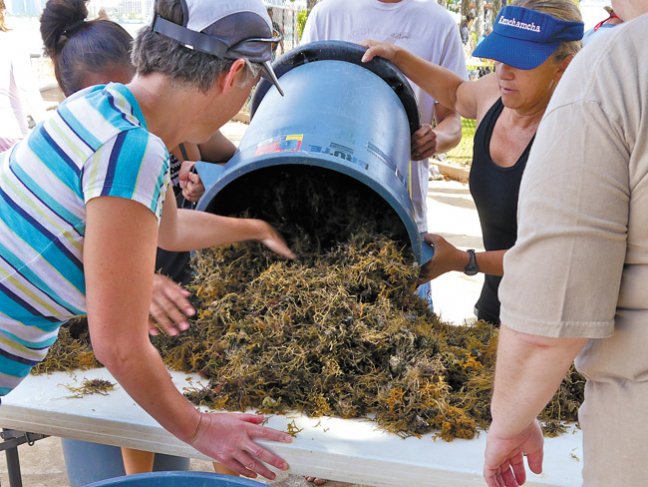Cleaning The Ocean’s Dirty Gym Socks
Imagine, if you will, a nasty pair of old gym socks sitting in a pile of clean laundry — certainly not the prettiest of sights, especially when that load is fresh and has no room for the unwanted guest.
Now, imagine that image multiplying over and over again until the gym socks are so plentiful that they’re suffocating the life out of that once-clean environment.
mw-mizutani-032515-sort
The truth is, you don’t have to use your imagination to see this occurring. Just head to the ocean near Waikiki Aquarium and take a good look at the coral reefs that call the area home.
No, you won’t find old gym socks in the ocean (hopefully), but you will find something that is just as nasty and just as destructive.
Two invasive algae, gorilla ogo (Gracilaria salicornia) and leather mudweed (Avrainvillea amadelpha), quickly are taking control of our precious coral reefs.
“The reason those plants are present is because few species eat them,” explains Celia Smith of University of Hawaii-Manoa’s Botany Department. “They smell them and swim away. I call it the dirty gym socks!”
Smith is passionate about the subject that she says could develop into an islandwide crisis.
“These are the issues and the species that matter, and if we are not vigilant, the entire island could see this,” she says emphatically. “Is that acceptable to have the entire island surrounded by this? I don’t think it is.”
Waikiki Aquarium recently hosted an invasive algae cleanup in support of Smith’s work at UH. The regular cleanups provide the community with an opportunity to learn more about both native and invasive species, and lend a helping hand in preserving and protecting Hawaii’s marine life.
“Why should people care?” she asks. “Because healthy reefs protect our future. If we don’t have resilient coastlines, we’re in trouble. We need our reefs to be intact. And to the community’s credit, community support has been incredible. We have keiki to kupuna helping us, from 2 years old to 92.”
But the coral reefs weren’t always stressed in Waikiki. According to Smith, data from the 1960s show that native plants once dominated the area and marine life thrived. In fact, the area had only one invasive species back in the ’60s. Today, there are three dominant species blanketing our tropical reef ecosystems — and they’re winning the battle.
“How do we fix it?” asks Smith. “We need more tools in our toolkit. We need more eradication efforts and more science involved, and not just from botanists. We need to find different urchins or fish species that will eat the algae so that our reefs can be protected. We have to leave this reef region better than we first got it.”
The community will have another chance to make a difference in June, when Waikiki Aquarium will host its next cleanup. Smith encourages anyone who wants to participate to join them in their eradication projects.
“The leather mudweed came down the coast from Maunalua Bay in Hawaii Kai and made its way around Diamond Head about three years ago, and we need to stop it,” urges Smith. “We don’t know what eats it, and it is reproducing and growing at an alarming rate. We need to find something that can compete with it or we could see this surface in other parts of the island.”
And that’s something Smith takes personally.
“I wouldn’t be serving the community if I didn’t care,” she says with passion. “The spread of these non-native algae pose a great threat to our native marine creatures and animals. They are choking the life out of our reefs.”
It may not be as easy as throwing an old pair of gym socks in the wash or trash, but you’ve got to start somewhere. Why not Waikiki?
For more information on eradication efforts, go to waikikiaquarium.org/conservation/projects/invasive-algae-cleanups/.
rkmizutani@gmail.com






